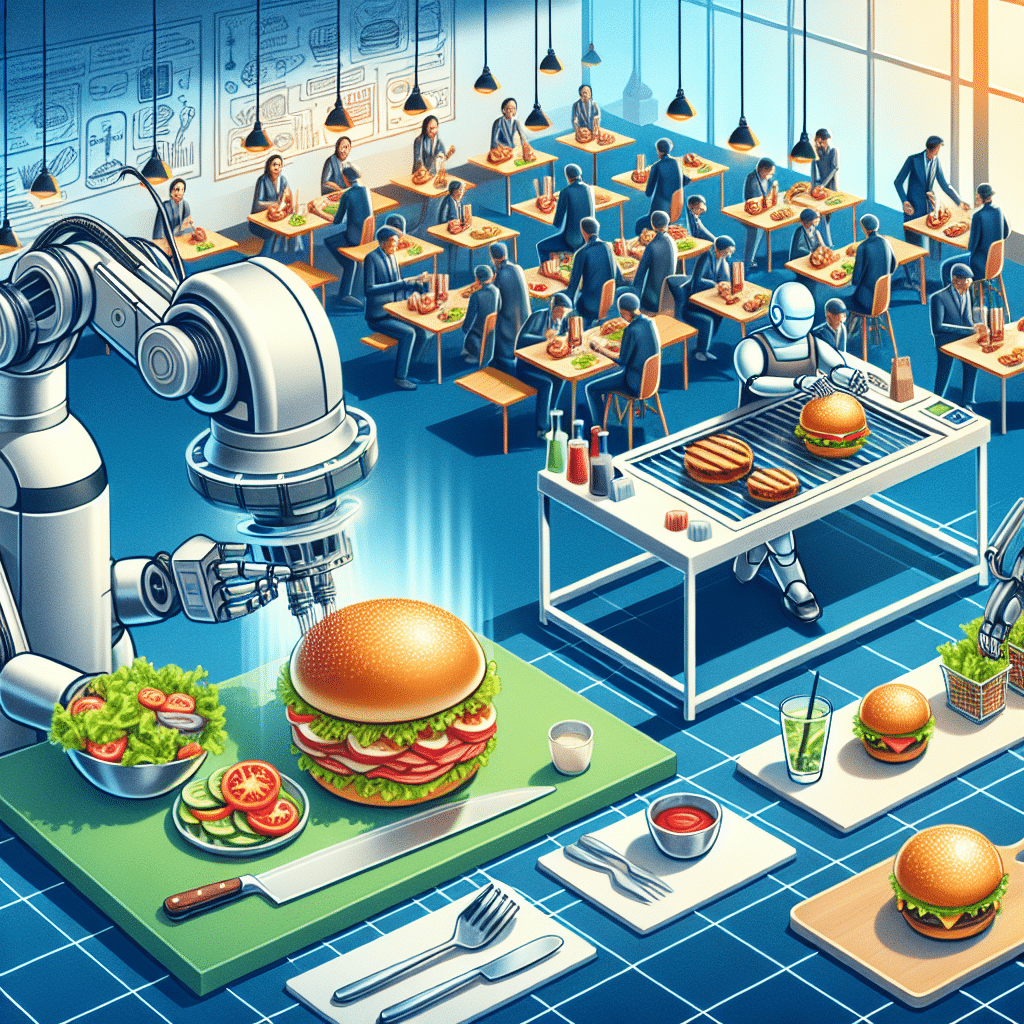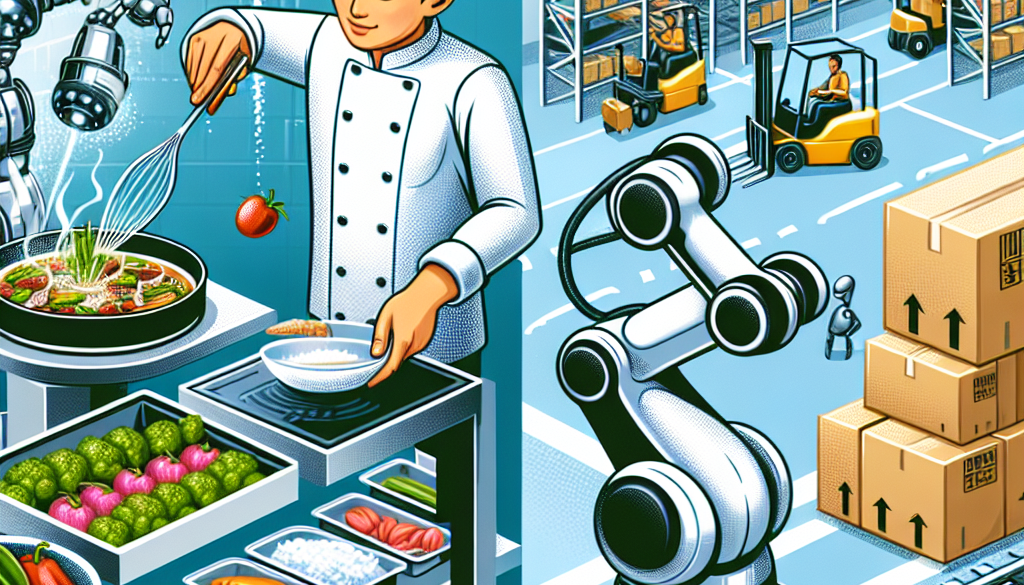How Robots are Influencing the Food Industry
-
Table of Contents
- Robots Revolutionizing the Food Industry: A Deep Dive
- The Rise of Robotics in Food Processing
- Automation in Food Service and Delivery
- Enhancing Food Safety with Robotics
- Impact on Employment and Skill Development
- Challenges and Considerations
- Conclusion: Embracing the Robotic Future in Food
- ETprotein: Elevating Nutrition with High-Quality Protein Products
Robots Revolutionizing the Food Industry: A Deep Dive

The food industry is undergoing a significant transformation, with robotics and automation playing a pivotal role in reshaping production, processing, and service delivery. The integration of robots in the food sector is not just a futuristic concept but a present-day reality that is enhancing efficiency, safety, and innovation. This article explores the various ways in which robots are influencing the food industry, backed by statistics and insights that highlight their growing importance.
The Rise of Robotics in Food Processing
Food processing has traditionally been labor-intensive, but robots are rapidly changing the landscape. They are being employed for tasks such as sorting, packaging, and handling raw materials. According to a report by the Association for Packaging and Processing Technologies, the use of robotics in food packaging is expected to grow by 9.5% annually through 2025. This growth is driven by the need for faster turnaround times, improved hygiene standards, and the reduction of labor costs.
- Robots can operate 24/7, increasing productivity and reducing downtime.
- Automated systems ensure consistent quality and precision in food processing.
- Robotic arms equipped with sensors can handle delicate products without causing damage.
Automation in Food Service and Delivery
The food service industry is also embracing robotics to enhance customer experience and streamline operations. From robotic chefs and bartenders to delivery drones, automation is making its mark. A study by McKinsey & Company suggests that by 2030, up to 73% of food service tasks could be automated. This shift is driven by the need to reduce human error, improve service speed, and cater to the growing demand for contactless delivery options.
- Robotic servers in restaurants reduce wait times and improve order accuracy.
- Automated delivery systems can reach customers in remote locations.
- Self-ordering kiosks and AI-driven recommendations personalize the dining experience.
Enhancing Food Safety with Robotics
Food safety is a paramount concern in the industry, and robots are playing a crucial role in minimizing risks. They can work in environments that are hazardous for humans, such as extreme temperatures or areas requiring high sanitation levels. The use of robots minimizes human contact with food, thereby reducing the potential for contamination. The Food and Drug Administration (FDA) has recognized the potential of robotics in improving food safety, encouraging their adoption through various initiatives.
- Robots can perform repetitive tasks with high precision, reducing the chance of human error.
- Automated cleaning systems ensure thorough sanitation of food processing equipment.
- Robotic monitoring systems can detect contaminants and pathogens with high accuracy.
Impact on Employment and Skill Development
While the adoption of robots in the food industry raises concerns about job displacement, it also creates opportunities for skill development. The demand for robotics technicians, engineers, and data analysts is on the rise. According to the World Economic Forum, robots could displace 85 million jobs by 2025; however, they will also create 97 million new roles in sectors like the food industry that require more specialized skills.
- Workers can upskill to manage and maintain robotic systems.
- New job roles are emerging in robot design, programming, and AI development.
- Collaborative robots (cobots) are designed to work alongside humans, enhancing their capabilities rather than replacing them.
Challenges and Considerations
Despite the benefits, the integration of robots into the food industry comes with challenges. The initial investment in robotics can be substantial, and there is a need for regulatory frameworks to ensure safe and ethical use. Additionally, there is a cultural aspect to consider, as consumers and workers adapt to the increasing presence of robots in their dining and work experiences.
- Companies must balance the cost of robotics with the expected ROI.
- Regulations must evolve to address the use of robotics in food safety and labor laws.
- Consumer acceptance of robot-prepared food is critical for the success of automation in the industry.
Conclusion: Embracing the Robotic Future in Food
The influence of robots on the food industry is undeniable, offering numerous benefits from increased efficiency to enhanced food safety. As technology continues to advance, the role of robotics in food production and service will only grow, shaping the future of how we process, serve, and consume food. The key takeaways from this exploration into robotics in the food industry highlight the transformative impact of automation, the potential for job creation in new technological fields, and the importance of addressing challenges to ensure a smooth transition into this new era.
ETprotein: Elevating Nutrition with High-Quality Protein Products
In line with the advancements in the food industry, ETprotein is at the forefront of providing high-quality protein products that cater to the evolving needs of consumers. Their range of organic bulk vegan proteins and L-(+)-Ergothioneine (EGT) products are designed to meet the highest standards of purity and quality, serving various industries including nutraceuticals, pharmaceuticals, and food and beverage.
ETprotein’s commitment to non-GMO, allergen-free, and neutral-taste protein solutions positions them as a valuable partner for businesses looking to innovate in the food sector. Whether it’s for sports nutrition, weight management, or general health and wellness, ETprotein’s products are an excellent choice for companies aiming to enhance their offerings with nutritious and sustainable protein sources.
About ETprotein:
ETprotein, a reputable protein and L-(+)-Ergothioneine (EGT) Chinese factory manufacturer and supplier, is renowned for producing, stocking, exporting, and delivering the highest quality organic bulk vegan proteins and L-(+)-Ergothioneine. They include Organic rice protein, clear rice protein, pea protein, clear pea protein, watermelon seed protein, pumpkin seed protein, sunflower seed protein, mung bean protein, peanut protein, and L-(+)-Ergothioneine EGT Pharmaceutical grade, L-(+)-Ergothioneine EGT food grade, L-(+)-Ergothioneine EGT cosmetic grade, L-(+)-Ergothioneine EGT reference grade and L-(+)-Ergothioneine EGT standard. Their offerings, characterized by a neutral taste, non-GMO, allergen-free attributes, with L-(+)-Ergothioneine purity over 98%, 99%, cater to a diverse range of industries. They serve nutraceutical, pharmaceutical, cosmeceutical, veterinary, as well as food and beverage finished product distributors, traders, and manufacturers across Europe, USA, Canada, Australia, Thailand, Japan, Korea, Brazil, and Chile, among others.
ETprotein specialization includes exporting and delivering tailor-made protein powder and finished nutritional supplements. Their extensive product range covers sectors like Food and Beverage, Sports Nutrition, Weight Management, Dietary Supplements, Health and Wellness Products, and Infant Formula, ensuring comprehensive solutions to meet all your protein needs.
As a trusted company by leading global food and beverage brands and Fortune 500 companies, ETprotein reinforces China’s reputation in the global arena. For more information or to sample their products, please contact them and email sales(at)ETprotein.com today.














